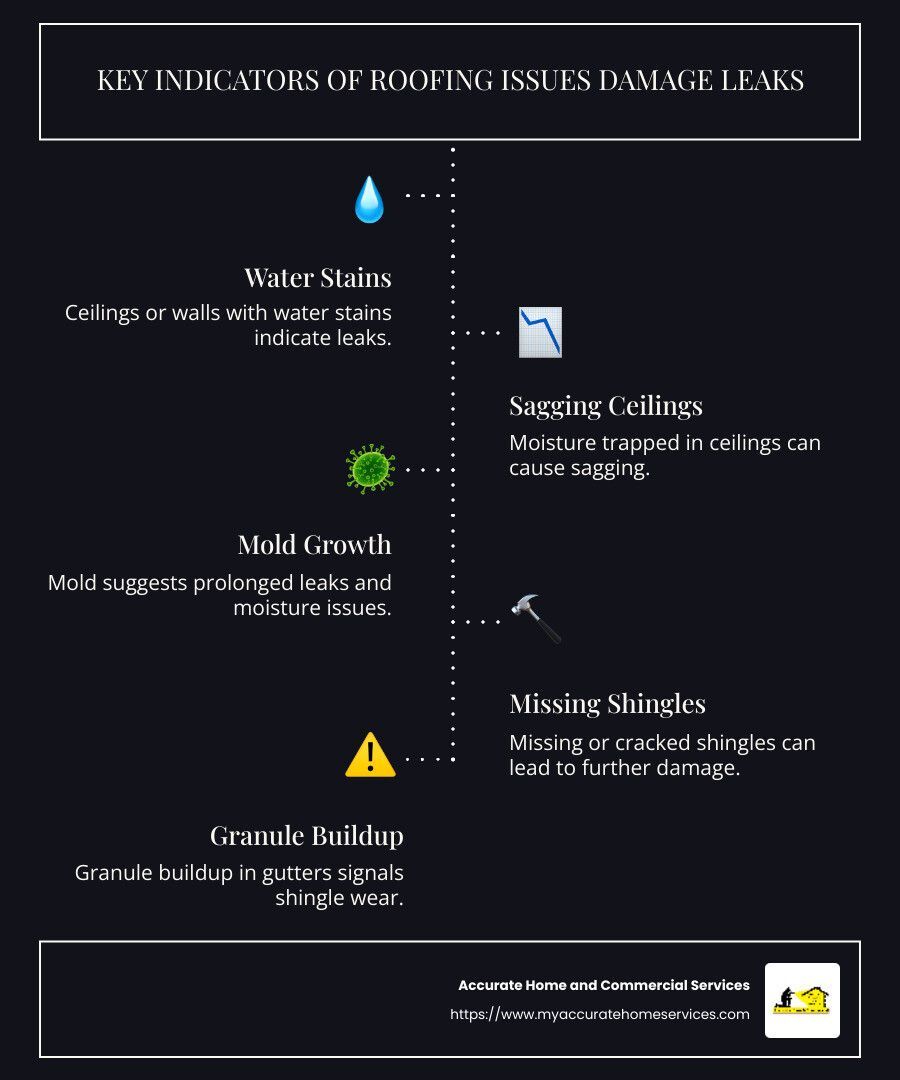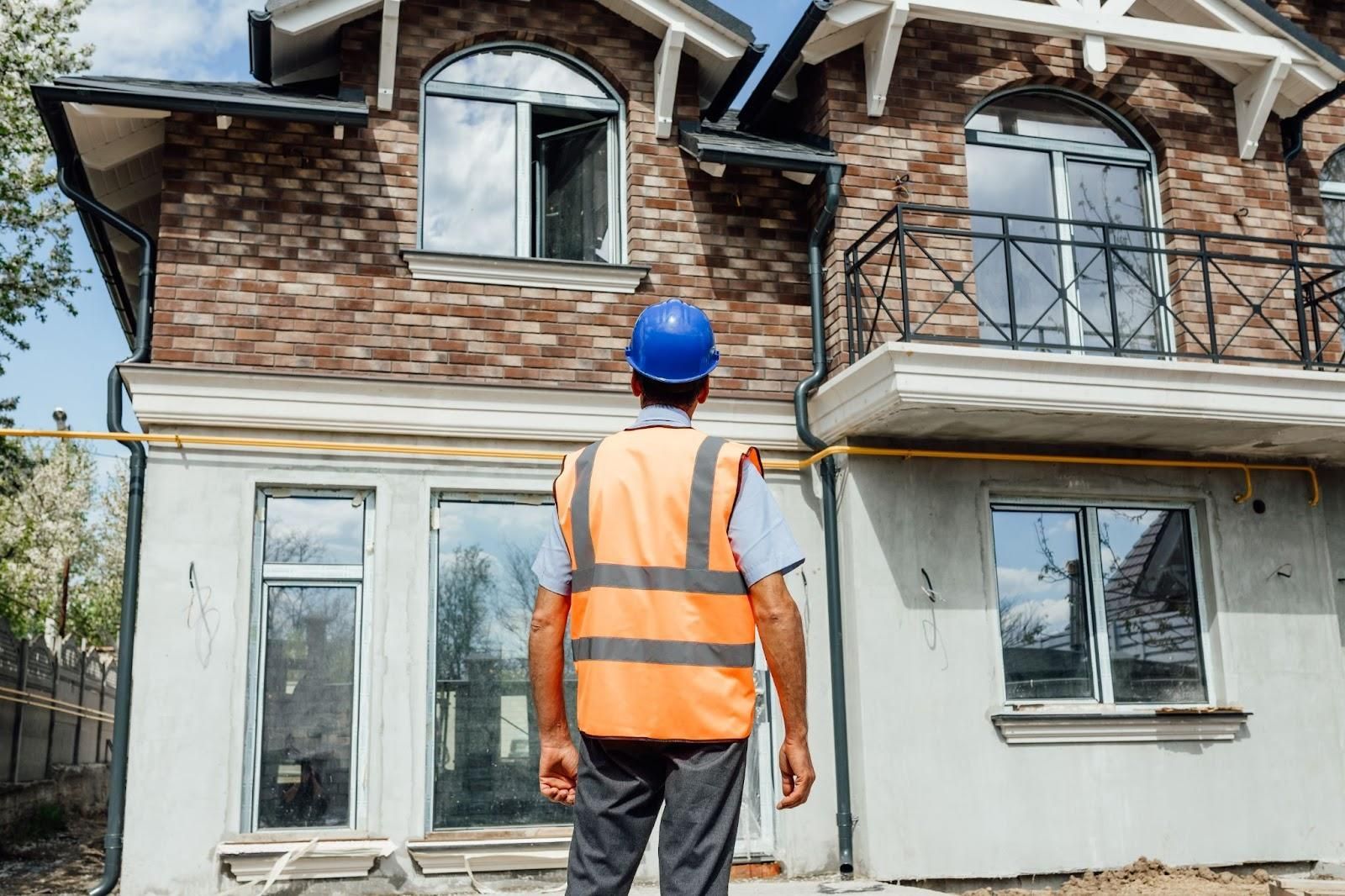How To Identify Roofing Issues
Roofing issues damage leaks are common concerns for homeowners that often go unnoticed until they lead to significant problems. Detecting these issues early is crucial to maintaining your home's safety and value.
To quickly identify potential concerns:
- Water stains on ceilings or walls.
- Sagging ceilings indicating trapped moisture.
- Mold growth suggesting a prolonged leak.
- Missing or cracked shingles often lead to further damage.
- Granule buildup in gutters signals shingle wear.
Understanding these signs can prevent costly repairs and ensure your home remains a secure and comfortable environment. Keep reading to learn detailed strategies for identifying and addressing these common roofing problems.

Recognizing Common Roofing Issues
Spotting roofing issues damage leaks early can save you a lot of trouble and money. Here are some common problems to watch out for:
Cracked Shingles
Cracked shingles are a telltale sign of wear and tear. They can occur due to age, weather exposure, or improper installation. Cracks let water seep through, leading to leaks and further damage. To check for cracked shingles, look for visible splits or gaps on the roof surface.
Granule-Filled Gutters
Finding granules in your gutters? That’s a red flag. Granule-filled gutters indicate that your shingles are losing their protective layer. This often happens after a hailstorm or as shingles age. Without granules, shingles become vulnerable to UV rays, which can speed up deterioration.
Improper Installation
Poor installation is a hidden threat. Even if your roof looks fine, improper installation can cause problems down the line. Signs include uneven shingle lines, exposed nails, or shingles that appear loose. These issues can lead to leaks and reduced roof lifespan.
Recognizing these common roofing issues is the first step in preventing major damage. Next, we'll explore the causes of these problems and how to address them effectively.
Identifying Signs of Roof Damage
Spotting signs of roofing issues damage leaks early is crucial to avoid costly repairs. Here are some key indicators to watch for.
Water Stains
Water stains on your ceiling are often the first visible sign of a roof leak. These stains usually appear as dark, discolored patches and can be circular or irregular in shape. They often indicate that water is seeping through the roof and into your home's interior. If you notice water stains, it's important to investigate further to find the source of the leak.
Sagging Ceilings
A sagging ceiling is a more severe sign of water damage. This occurs when water accumulates in the ceiling material, causing it to weaken and droop. Sagging can be dangerous, as it might lead to a ceiling collapse. If you observe any sagging, it's crucial to address the issue immediately by seeking professional help.
Mold Growth
Mold thrives in damp, hidden areas, making it a common consequence of roof leaks. Mold growth can be identified by its musty smell and the appearance of black, green, or white patches on walls and ceilings. Mold not only damages your home but also poses health risks, particularly to those with respiratory issues. Detecting and addressing mold promptly is essential to maintaining a safe living environment.
Identifying these signs of roof damage early can help you take swift action to prevent further deterioration. In the next section, we'll dig into the causes of these roofing issues and how to effectively address them.
Causes of Roofing Issues Damage Leaks
Understanding the root causes of roofing issues damage leaks can help you prevent them from happening in the first place. Let's explore some common culprits.
Cracked Flashing
Flashing is a thin material, usually metal, installed to direct water away from critical areas like chimneys, skylights, and vents. Over time, flashing can crack due to weather exposure or improper installation. When flashing cracks, water can seep into your home, leading to leaks and water damage. Regular inspections can help spot these cracks early, preventing more extensive repairs later.
Clogged Gutters
Gutters are designed to channel rainwater away from your roof and foundation. However, leaves, twigs, and debris can clog them, causing water to back up. This can lead to water spilling over the sides, soaking your roof's edges, and eventually causing leaks. Regular gutter cleaning is essential to ensure proper water flow and prevent leaks.
Condensation
Condensation happens when warm, moist air inside your home meets a cooler surface, like the underside of your roof. This moisture can accumulate and lead to water damage or mold growth. Proper attic ventilation helps regulate temperature and humidity levels, reducing the risk of condensation-related issues.
By understanding these causes, you can take proactive steps to maintain your roof's integrity. In the next section, we'll discuss how to effectively address these roofing issues and explore the best repair options available.
How to Address Roofing Issues Damage Leaks
Addressing roofing issues damage leaks requires a combination of professional help, effective repair strategies, and understanding your insurance coverage. Here’s how you can tackle these problems efficiently.
Professional Inspection
How to Address Roofing Issues Damage Leaks
The fundamental step in tackling roofing problems is to schedule a professional inspection. Specialists have the expertise to detect hidden damage that often goes unnoticed by homeowners. By identifying these issues early, you can save significant costs over time, as minor problems can quickly escalate into expensive repairs if ignored.
Therefore, regular roof inspections are not just a preventative measure but a smart investment in your property's longevity and safety.
Repair Options
Once the inspection is complete, you’ll have a better idea of the necessary repairs. Here are some common repair options:
- Shingle Replacement: If your roof has missing or damaged shingles, replacing them promptly can prevent leaks and further damage.
- Flashing Repair: Cracked or damaged flashing should be repaired or replaced to ensure water is directed away from vulnerable areas like chimneys and vents.
- Gutter Maintenance: Cleaning and repairing gutters can prevent water from backing up and causing leaks. Consider adding gutter guards to minimize debris buildup.
For extensive damage, hiring a professional roofer is recommended. They have the tools and expertise to safely and effectively repair your roof.
Insurance Coverage
Understanding your homeowners insurance policy is key when dealing with roof damage. Most policies cover damage from sudden and accidental events, like a storm, but not from wear and tear.
Before filing a claim, evaluate the cost of repairs against your deductible. If the repair cost is lower, it might not be worth filing a claim, as this could affect your future premiums. When your roof is damaged due to a covered event, contact your insurance company promptly to start the claims process. Keep detailed records of damages and repair estimates to support your claim.
By addressing roofing issues damage leaks promptly and effectively, you can protect your home and avoid costly repairs in the future. In the next section, we’ll explore preventive measures to keep your roof in top condition.
Preventing Future Roofing Problems
Preventing roofing issues is about regular care and attention. Here’s how you can keep your roof in top shape and avoid costly repairs.
Regular Maintenance
Regular maintenance is your first line of defense against roofing issues. Schedule professional inspections at least once a year. These inspections can catch minor problems before they become major headaches. Experts can identify issues like cracked shingles or damaged flashing that you might miss.
Gutter Cleaning
Clean gutters are crucial for a healthy roof. Clogged gutters can cause water to back up, leading to leaks and water damage. Make sure to clean your gutters regularly, especially after heavy storms or falling leaves. Consider installing gutter guards to reduce debris buildup and make cleaning easier.
Tree Trimming
Overhanging tree branches can cause serious damage to your roof. They can fall during storms, leading to broken shingles or punctures. Regularly trim back any branches that hang over your roof. This not only protects your roof but also reduces the amount of leaves and debris that can clog gutters.
By focusing on regular maintenance, gutter cleaning, and tree trimming, you can prevent many common roofing issues. These simple steps will help you avoid roofing issues damage leaks and keep your home safe and dry.
Next, we’ll answer some frequently asked questions about roofing issues and how they can affect your home.
Frequently Asked Questions about Roofing Issues Damage Leaks
What damage can a leaky roof cause?
A leaky roof can lead to several types of damage in your home. Water damage is the most immediate concern. Water can seep into your attic, damaging insulation and causing wood rot. Over time, this can lead to structural damage, weakening your home's framework and potentially causing a collapsed ceiling.
Another major issue is mold growth. Mold thrives in damp conditions, and a leaky roof provides the perfect environment. Mold can spread quickly, affecting your walls, ceilings, and even your HVAC system. Mold not only damages your home but can also cause health problems like allergies and respiratory issues.
Is damage from a roof leak covered by insurance?
Whether your insurance will cover damage from a roof leak depends on your policy. Most homeowners' insurance policies cover damage from sudden and accidental events, such as a storm. However, they typically do not cover damage due to wear and tear or lack of maintenance.
If your roof leak is due to a covered event, you can file a claim. Be sure to check your policy guidelines for details on what is covered. That filing a claim may affect future premiums, so weigh the cost of repairs against your deductible before deciding to file.
Can a leaking roof cause electrical problems?
Yes, a leaking roof can pose serious safety concerns if water comes into contact with electrical wiring. Water can cause short circuits, leading to a potential fire hazard. If you suspect water has reached your electrical system, it's crucial to turn off electricity to the affected area immediately.
Consult with an electrician to assess any electrical wiring issues. They can ensure your home is safe and prevent any further damage. Always prioritize safety when dealing with potential electrical problems caused by a leaking roof.
By understanding the potential damage a leaky roof can cause, the insurance process, and the safety risks involved, you can better protect your home and family. Next, we'll conclude with how Accurate Home and Commercial Services can help ensure your roof remains in excellent condition.
Conclusion
Keeping your roof in top condition is crucial for the safety and value of your home. Accurate Home and Commercial Services, based in Conroe, TX, offers comprehensive inspections to help you identify and address any roofing issues, damage, or leaks before they become major problems.
Their team of experts provides thorough inspections, focusing on every detail to ensure nothing is missed. This dedication to detail helps you catch potential issues early, saving you time and money on costly repairs. With their extensive experience in the Greater Houston area, they understand the unique challenges local weather can pose to your roof.
Customer satisfaction is their top priority. They work closely with you to ensure your concerns are addressed and your home is safe. Whether it's a routine inspection or addressing specific roofing problems, their goal is to provide you with peace of mind.
By choosing Accurate Home and Commercial Services, you're investing in the longevity and integrity of your home. Their commitment to excellence ensures that your roof remains strong and reliable, protecting your family and property for years to come.
For more information or to schedule an inspection, contact Accurate Home and Commercial Services today. Let them help you maintain a safe and secure home environment.











